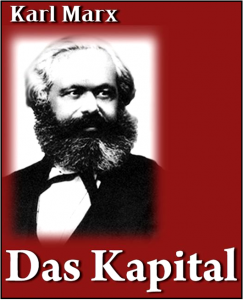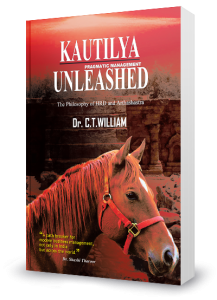Kautilya Arthashastra and Das Kapital
08 Feb 2017
 It is very evident that Kautilya with his foresight and insight has formulated his own strategic economic policies that interlinked with the human resource development policies. This interlink has finally resulted in the idea of economic liberalization. The Philosophy of Human Resource Development (HRD) and the science of economic liberalization have ideologically synthesized later. Dr. P. Subba Rao has described this synthesis as follows: – “HRD assumes significance in view of the fast changing organizational environments and need of the organization to adopt new techniques in order to respond to the environmental changes. The changing environmental factors include: unprecedented increase in competition within and outside the country consequent upon the announcement and implementation of economic liberalizations.” It is this Strategy of Human Resource Development (HRD) that enables the society to overcome such unprecedented increase in competitive trends. It is this scientific Human Resource Planning (HRP) that capacitates the society for this task and the capacity will work in the present as well as in the future.
It is very evident that Kautilya with his foresight and insight has formulated his own strategic economic policies that interlinked with the human resource development policies. This interlink has finally resulted in the idea of economic liberalization. The Philosophy of Human Resource Development (HRD) and the science of economic liberalization have ideologically synthesized later. Dr. P. Subba Rao has described this synthesis as follows: – “HRD assumes significance in view of the fast changing organizational environments and need of the organization to adopt new techniques in order to respond to the environmental changes. The changing environmental factors include: unprecedented increase in competition within and outside the country consequent upon the announcement and implementation of economic liberalizations.” It is this Strategy of Human Resource Development (HRD) that enables the society to overcome such unprecedented increase in competitive trends. It is this scientific Human Resource Planning (HRP) that capacitates the society for this task and the capacity will work in the present as well as in the future.
In the modern context, where the role of HRD has been considered as decisive in the process of enhancing the efficiency of Administration and Management; the practical administrative solutions as envisaged in Arthashastra are remarkably relevant. It can also be proved that those practical administrative solutions have the nature of a successful continuum from the past to present.
The Philosophy of Human Resource Development (HRD) is nowadays widely discussed among the Gurus of modern administration and management who are still exploring the unfathomable possibilities of human resource management in their management school laboratories. The ultimate aim of this book therefore is to explain the practical application of HRD in the context of Kautilyan philosophy, in the areas of administration and management of the simple organizations to the compound and complex organizations in the state or nation.
It is believed that Leonard Naddler was the first management thinker who drafted the concept of Human Resource Development (HRD). He had introduced the concept through the research paper he presented in the American Society for Training and Development during 1969. He has defined Human Resource Development (HRD) as “those learning experiences which are organized, for a specific time, and designed to bring about the possibility of behavioral change”. This primary definition of Naddler is but a blank statement of an earlier interpreter of the colonial administration. Later, this blank statement on management thought along with its aftershocks has been imposed on the global management community.
The concept of Human Resource Development (HRD) formulated by Naddler, has confronted many transitions later and finally reached the active arena of innovative educational methods, sociological developments and observations of behavioral science.
The three enabling factors that bring Human Resource Development (HRD) to the forefront of Human Resource Management are: –
1) Acquiring or sharpening of capabilities required to perform various functions associated with their present or expected future roles.[Acquisition of resources]
2) Developing their general capabilities as individuals and discovering and exploiting their own inner potentials for their own or organizational purposes.[HRD]
3) 3.Developing organizational culture in which superior-subordinate relationship, team work and collaboration among subunits are strong and contribute to the professional well-being, motivation and pride of employees.[Retention of the acquired resources]
Kautilyan thought-the forerunner of Marxian Philosophy.
Apart from these three factors it has been recently proved that the conceptual application of Human Resource Development (HRD) should be in tune with the culture of the nation and its people. The great Kautilya and his conceptual analysis of HRD are to be discussed in this context; because Kautilya has worked out his concept of Human Resource Development (HRD) based on the Indian culture bed-rocked on the philosophic constituents Dharma, Artha, Kama and Moksha [Purushartha]. All human resource activities including the salary administration are to be placed before the principles of Purushartha. “ The salary scale shall be such as to enable the accomplishment of state activities (by attracting the Right type of people) , shall be adequate for meeting the bodily needs of the state servants and shall not be in contradiction to the principles of Dharma and Artha” {Bk.5.Ch.3.Vs.2.}. Here the salary scale is commensurate with the accomplishment of the state-building activities and the maintenance of individual existential needs; both adhering to the principles of Dharma, Artha, Kama and Moksha [Purushartha]. There was in fact a strict maintenance and control of this principle and its phases of implementation; which often alleged as monarchical imposition on people. This monarchical imposition has invited sharp criticism from the Marxist schools of thinkers and ideologists. But as alleged, this monarchical interference is not an attack on the fundamental freedom of the individual or the society. This is but the powerful process of acquisition of the human asset or capital [Prithvilabham] and the practical process of retention of the acquired skills and knowledge [Prithvipalanam].
The state in Arthashastra is composed of various constituent elements which are collectively known as Prakriti. The state constituting these elements, Prakriti; is termed as Prakriti Sampath. Prakriti Sampath is the human asset or capital, which is well protected and preserved by the king. It is this human asset or capital that determines the quality of a state. Prakriti Sampath is composed of constituents such as: (1) the king [Rajah and Yuvarajah] (2) group of high officials [Amathya] (3) the territory with the inhabitants [Janapada] (4) the fortified towns and cities [Durga] (5) the treasury [Kosa] (6) the forces [Dhanda] (7) the allies [Mitra]. {Bk. 6.Ch.1.Vs.1.}. The higher the quality of these constituent elements [Prakriti Sampath], the greater will be the people’s prosperity and welfare [Yogakshema]. If the quality of these constituent elements [Prakriti Sampath] is not ensured, it will weaken the people’s prosperity and welfare [Yogakshema] and also entertain the inevitable emergence of rebels. In the 13th Sutra of Chanakyasutra, chapter 1, it is stated that the country will be ruled automatically even without a leader or a King (Nayak or Rajah), if the quality of these constituent elements [Prakriti Sampath] is ensured to bring people’s prosperity and welfare [Yogakshema].
“Prakriti Sampatha hyanayakamapi rajyam niyathe”
Chanakyasutra-Chapter-1, Sutra-13
This epigram can be equated with the Marxian philosophy where in the final stage “the state withers away” and the people are ruled automatically even without a ruler [Nayak]. In Marxian philosophy, the concept of human asset or capital is treated as the proletariat; the community of the working class. It is this proletariat that in its final stage attains socialism [Yogakshema] and at last the state withers away. In Kautilyan context, this is a process of administrative automation with Prithvilabham (The acquisition of Yogakshema [socialist state]) and Prithvipalanam (The retention of the Yogakshema [socialist state]).
- I. Lenin elucidates this fact:- “The first step in this process is the seizure of political power by the working class majority of society; known in Marx’s day as the “dictatorship of the proletariat” as opposed to the “dictatorship of the bourgeoisie” we currently live under. Once in political power, the working class can then move to assert its control over the economy. Once the working class democratically runs the economy in the interests of all, instead of in the interests of a handful of capitalists, and then very quickly we will be able to provide the basic necessities and then much more to everyone. We will be able to abolish unemployment, provide free, quality healthcare, education, housing, and more to everyone. The creative and productive potential of humanity will be unleashed. [Prakriti Sampath]
As Friedrich Engels explained, this socialist “state”, which would truly democratically represent the vast majority of society, would already be withering away in the proper sense of the word. The capitalist state represents a tiny minority  of society, which is why they resort to such brutal measures to keep the majority under their boot. But once the state is run in the interests of the majority, then the need for police, a military, etc. will rapidly disappear along with the inequality and oppression of the capitalist system. Gradually, the coercion and compulsion of the capitalist system will disappear, replaced by the democratic administration of things in the interests of everyone [Yogakshema]”. (The State and Revolution V. I. Lenin, 1917, www.marxists.org/archive/lenin/works/1917/staterev/ch05.htm)
of society, which is why they resort to such brutal measures to keep the majority under their boot. But once the state is run in the interests of the majority, then the need for police, a military, etc. will rapidly disappear along with the inequality and oppression of the capitalist system. Gradually, the coercion and compulsion of the capitalist system will disappear, replaced by the democratic administration of things in the interests of everyone [Yogakshema]”. (The State and Revolution V. I. Lenin, 1917, www.marxists.org/archive/lenin/works/1917/staterev/ch05.htm)
Reference : Kautilya Unleashed; Partridge: Dr.C.T. William.